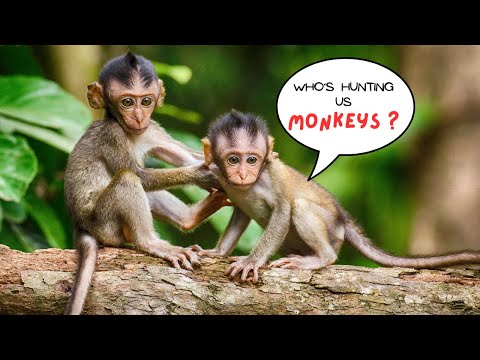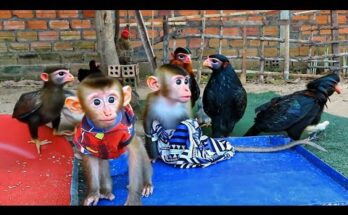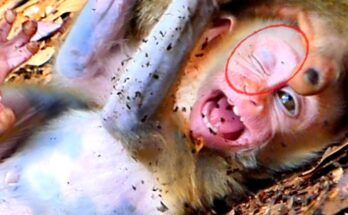
Monkeys live in close-knit troops that rely heavily on communication and teamwork to survive. When a predator is nearby, alarm calls echo through the treetops, warning others to stay hidden or flee. But this time, the threat is harder to identify. The monkeys have heard strange movements in the underbrush, branches snapping, and unfamiliar scents drifting through the forest. Could it be a leopard, silently stalking its prey? Or perhaps a large python slithering closer?
The troop’s leader, a strong alpha male, sits at the edge of a thick branch, scanning the area with sharp eyes. He knows that one mistake could cost lives. The babies cling to their mothers, their tiny hearts beating fast as they sense the tension around them. Every sound in the forest is magnified—the crack of a twig, the distant call of a bird, the rustle of leaves.
Suddenly, a loud crash echoes through the jungle, and panic erupts. The monkeys scatter, leaping from branch to branch, calling frantically to one another. This burst of energy is not random—it’s a calculated survival tactic. By moving quickly and unpredictably, they make it harder for predators to single out a target. But the fear remains: who is hunting them?
In many parts of the world, monkeys face a variety of threats. In the wild, natural predators like big cats, crocodiles, and large snakes can wipe out individuals from a troop. But perhaps the greatest danger they face is from humans. Hunting for bushmeat, illegal poaching for the pet trade, and habitat destruction have all contributed to declining monkey populations. For these monkeys, the rustling in the forest could just as easily come from a poacher with a gun or a snare as it could from a leopard.
As night falls, the troop climbs higher into the tallest trees they can find. They choose a sleeping site where branches are strong and visibility is good, giving them a better chance to spot danger. They huddle together for warmth and reassurance, their bodies pressed close as they settle in for a restless night.
The fear of the unknown is one of the greatest challenges they face. Whether it’s a stealthy predator or a human hunter, the monkeys must remain vigilant at all times. Their survival depends on their ability to work together, respond to alarms, and trust their instincts.
This story is not just about one troop’s fear; it is a reflection of the growing pressures monkeys face across the globe. Their habitats are shrinking, and their natural predators are no longer their only concern. Humans, too, have become hunters, whether intentionally or through the destruction of the forests they call home.
Who is hunting the monkeys? Sometimes the answer is clear, but often, the fear itself is enough to keep them on edge. It is a reminder of how fragile life in the wild can be and how urgently we need to protect these intelligent, social animals and the ecosystems they depend on.


